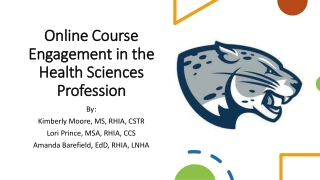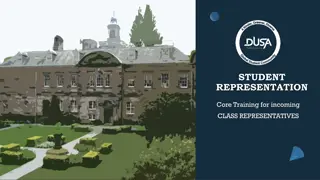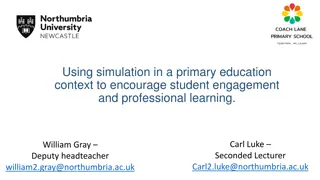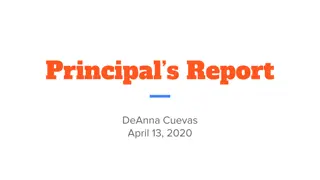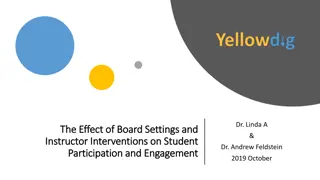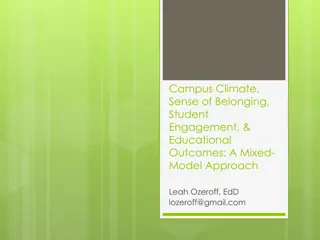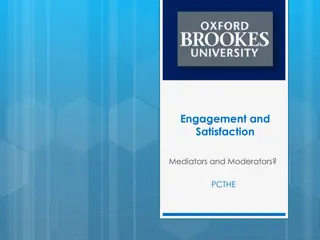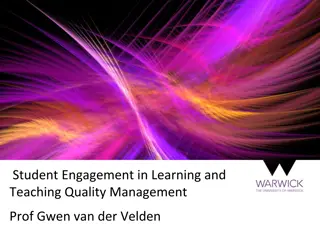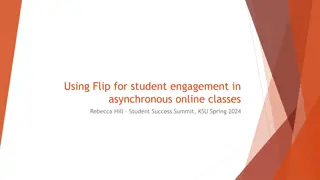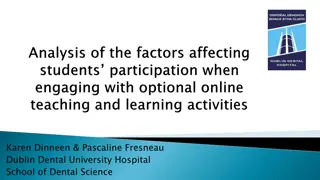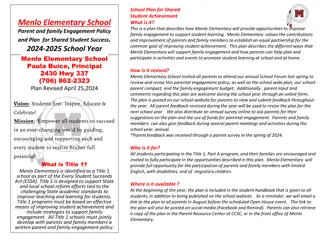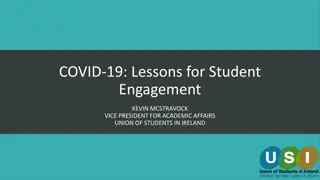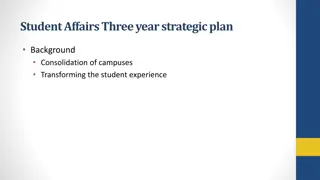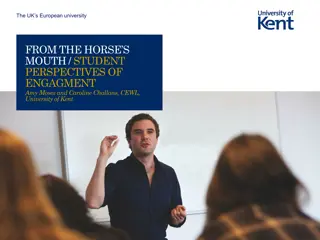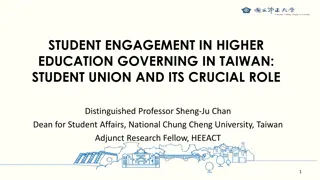Fostering Student Engagement in Class & Online Training
Staff training plays a vital role in enhancing student engagement in both physical classrooms and online platforms. The global uptake of technology has reshaped education, leading to a surge in online enrollment. The COVID-19 pandemic accelerated the shift to online learning, highlighting the need for pedagogical adaptation. Higher education institutions faced challenges in transitioning to online platforms, emphasizing the importance of pedagogical content knowledge for effective course design and student engagement.
Download Presentation

Please find below an Image/Link to download the presentation.
The content on the website is provided AS IS for your information and personal use only. It may not be sold, licensed, or shared on other websites without obtaining consent from the author.If you encounter any issues during the download, it is possible that the publisher has removed the file from their server.
You are allowed to download the files provided on this website for personal or commercial use, subject to the condition that they are used lawfully. All files are the property of their respective owners.
The content on the website is provided AS IS for your information and personal use only. It may not be sold, licensed, or shared on other websites without obtaining consent from the author.
E N D
Presentation Transcript
Academic Staff Training Fostering Student Engagement in class & online: How to do this T. Fola-Adebayo GNS Dept The Federal University of Technology
GLOBAL UPTAKE OF TECHNOLOGY The global growth and uptake of technology has been high in advanced countries resulting in global investments of the United States reaching $18.66 billion in 2019 (El Said, 2021), and an estimated $350 billion by 2025 (World Economic Forum, 2020).
The annual growth rate of enrolment online in 2015 saw rapid increase of well over 30% each year, the number of students offering at least one online course grew to 34.7% of the population of learners globally (DAAD, 2020).
The outbreak of the covid-19 pandemic led to restrictions on physical interactions in classrooms, and this led to a further rise in the number of students taking advantageof distance learning.
The pandemic marked a watershed in pedagogic practice in higher education (HE), globally. The reality of the pandemic highlighted the need to quickly embrace online learning and transfer our courses from face-to- face toonline platforms.
The challenges for higher education institutions (HEIs) in sub-Saharan Africa where the uptake of the adoption and deployment of technology is rather low. Key among the many challenges faced by HEIs was the urgent need toswitch toonline platforms. sudden shift to online platforms created
This sudden shift was worsened by the fact that it was done without the necessary pedagogical content knowledge (PCK) on the part of teachers. This kind of knowledge requires careful design of online courses and systematic organization of students learning experience in order to facilitate learning, student engagement and the convergence of cognitive, social and teaching presences.
Need for this training exercise Equip Teachers with skills that will help them integrate technology in teaching and learning Foster learner engagement Guarantee quality assurance Expand students learning spaces Produce knowledge creators, not consumers of information Teach students relevant ICT skills and competencies- visa for participating in 21stcentury academic discourse
Fostering Student Engagement The three Musketeers: Cognitive, Social and Teaching Presences. Garrison et al (2000) present a conceptual framework that specifies the elements that are crucial for a successful higher education experience. This is captured in the interplay of three core elements: Cognitive Presence, Social Presence and Teaching Presence (multidimensional, interdependent and must combine tocreatean educational experience).
BLENDED LEARNING? BL is the convergence of text-based asynchronous Internet-based learning with face-to-face approaches. A paradigm shift where the emphasis moves from teaching to learning (Nunan, George and McCausland, 2000). A pedagogic design that encourages students to learn interactively and collaboratively, and at their own pace and time BL
Blended Learning: Takes into account the quality and quantity of the interaction that will be generated, and the sense of engagement in a community of inquiry and learning. Facilitates ubiquitous independent and collaborative learning experience. Promotes the establishment of a community of learning that comprises three key elements in a learning encounter: cognitive, social and teaching presences. learning, simultaneous
BENEFITS OF BLENDED LEARNING: Pedagogic richness, accessibility to knowledge, social interaction, learner control effectiveness and ease of revision reinforcement of student s learning autonomy, reflective thinking and powers of research (Tam, 2000) and choice, cost
MORE BENEFITS: Promotes meaning and enhanced educational experiences Facilitates critical thinking learning, and deep thinking which moves through distinct phases of triggering event, exploration, integration and application Facilitates the creation of community of learning and the development of the skill of teamwork + higher-order
Community of Inquiry Model The interdependency of these 3 elements in an online environment helps to create a community that gives room for critical discourse, critical thinking and reflection among learners.
Cognitive Presence? Cognitive Presence refers to the extent to which learners are able to construct and confirm meaning through sustained reflection and discourse in a critical community of inquiry (Garrison, Anderson and Archer, 2001: 11). This component comprises four phases: triggering event, exploration, integration, and resolution.
Social Presence? Social Presence is the ability of participants in the Community of Inquiry to project their personal characteristics into the community, thereby presenting themselves to the other participants as realpeople (Garrison et al., 2000: 89). Three constructs: affective expression, open communication group cohesion.
Teaching presence? Teaching presence is defined as the design, facilitation and direction of cognitive and social processes for the purpose of realizing personally meaningful and educationally worthwhile learning outcomes (Anderson, Rourke, Garrison and Archer, 2001: 5). The activities: Instructional design and organisation, facilitating discourse and direct instruction.
TP focuses on the functions of the teacher to communicate instructional design and organisation to students, facilitate useful discourse among learners, and provide direct instruction in a way that will engage students to effectively take part in the learning process and learn from discussions at hand.
1st indicator of TP: Design and organisation Refers to the role of the teacher in establishing curriculum contents, learning activities and timelines. The teacher plans and organises learning activities, assigns roles to students, and determines their interaction pattern.
2nd indicator of TP: Facilitating discourse Facilitating discourse involves the role of the teacher in helping students to understand the topics discussed. The teacher use TP to engage students in interacting and building on the information provided in the course materials. TP influences the creation and sustainability of social and cognitive presence.
3rd Indicator of TP: direct instruction This refers to the intellectual and scholarly leadership the teacher provides based on his or her subject matter expertise. DI is done by providing academic support for students by presenting content and questions, focusing and summarizing discussion, confirming understanding, misperceptions, injecting knowledge from diverse sources, and responding to technical concerns (Garrison et al., 2001). confirming discussion, diagnosing
How to foster the 3 presences Cognitive Presence Social Presence Teaching Presence
COGNITIVE PRESENCE Categories Sample Indicators (examples only) Statements Triggering event sense of puzzlement, questioning the applicability of course content After the class with Mrs , i was wondering the folowing. please guys and girls what are the usefulness of summary writing taking a course like Physics 102? Covid 19 in Nigeria. What is Covid-19? Origin? How do we delimit the topic? Ma, is this topic ok. Covid 19 and climate change? Exploration Individual and collective exploration of the problem. Brainstorming, questioning, sharing and information, and adding to the knowledge established or expressed. Re: What are the effect of coffee drinking on the human brain? experiences Just google adverse effect of coffee on the brain. There is no need for words. Ma, is Covid-19 and education in Nigeria ok? What about Covid-19 and health in Nigeria? Participants react to the initial problem in greater depth through brainstorming, questioning, sharing experiences and information. Ok Ma, so can we look at Covid 19 and traditional remedies in South West Nigeria? Re: refine it further. Integration The problem is resolved or learners transfer knowledge acquired to solve other related problems. What about this, Covid 19 and steam inhalation in Ikere-Ekiti? Resolution
SOCIAL PRESENCE Indicators (examples only) Categories Sample Statements Affective expression This is characterised by the expression of emotions, feelings and mood I am not happy with my research location.my group and I have wasted over #2000 on transportation, before we were attended to was another case entirely I hope asuu call this strike of a thing off, we are tired of staying at home I'm so tired of Gns102, all this audited courses are killing me. Wish there were an easier way out... keep up the good work........... Open communication Posts here are risk-free: students reply directly to the posts of others using the reply feature, quoting directly from other people s posts and making references explicitly comments or posts. The existence of this level of social presence affords students opportunity to challenge, encourage and support one another Hello ma, i appreciate this gns course alot. It has broading my scope of learning. Bless you ma! to others E-learning is transforming and improving the learning method in Nigeria, hence I'm happy it's happening here in FUTA, thanks to the management staff, and also a very big 'thank you' to GNS dept Sorry o. Olamipo why do think abortion should be legalized Tina do you want me to believe you... Abiodun don't you think I want to encourage everybody to please take GNS102 so serious. From my findings, I have discovered that the most common and probable cause of failure are negligence and complacency... Group cohesion Group cohesion, the activities build and sustain a sense of group commitment. The indicators of group cohesion include the use of: phatics and salutations, vocatives, and inclusive pronouns such as we , our or us . Futa stands for federal university of tension and assignment,true or false? Re: Federal university of tension and agony
TEACHING PRESENCE Indicators (examples only) Refers to the role of the teacher in establishing curriculum learning activities and timelines. The teacher plans and organises learning activities, assigns roles to students. Categories Sample Design and organisation Statements A post is a discussion, question, comment or answer to a question made in good English. Pidgin is, of course, not acceptable. contents, Facilitating discourse This involves the role of the teacher in helping students to understand the topics discussed. The teacher engages students in interacting and building on the information provided in the course materials. None of the responses so far have answered the questions. I need to know in which particular area of your studies you use EACH of the FOUR LANGUAGE Itemise them and state what you use each for. Do this in your groups. After you have done justice to that aspect of the task, then think of other skills you use in your subject area and how you use them in your studies. SKILLS. Direct instruction Refers to the intellectual and scholarly leadership the teacher provides based on his or her subject matter expertise. The teacher provides academic support for students. by presenting Please mind what you post on this board. Ensure you focus more on weekly topics and not issues unrelated to your study, such as religion, relationships and politics. A link to the website 'Use of English for Academic Purposes' has been added to GNS 102.The
Fostering Social Presence Concept of Ubuntu Diversity = management of relationship. Diversity is about interconnections and similarities between what looks different. Bishop Tutu calls it the gift that Africa is going to give to the world . Ubuntu means I am a person through other persons or I am because you are, you are because we are .
1. Build trust. It forms the basis of our drive to contribute and engage online and trust is even referred to as the glue of relationships. Building an online community where there is open and enthusiastic interaction requires the facilitator to be a trust and relationship builder. Establish ground rules
2. Model the behaviour you wish to see and engage with participants as your authentic self. 3. Show respect and validate the different contributions of participants. 4. Encourage participants to move beyond the safe spaces of who and what they know and to be open to new and different experiences. 5. Encourage pair, peer, group work to break the ice. 6. Know your role: a conductor, orchestrator, arrangee
WHO AM I? My name is Titi Fola-Adebayo, a lecturer in the General Studies Unit of the Federal University of Technology, Akure, Nigeria. It s quiet where I am. I am working from home, courtesy of the lockdown over the Covid 19 pandemic. I told my family Mum s in School , a little blackmail to get away from distractions from them, and to have some leeway to do some work! I am busy learning how to facilitate online, while my children, for the umpteenth time, are busy making countless trips to the kitchen, refrigerator and back again. The sky is a lovely blend of light blue and gray, and from I am sitting, I can hear the gentle flutter of the branches of our neighbour s tall palm trees. To the right of the table where I am working, is a vase of beautiful red and pink roses, my favourite flowers.
Thank you for your attention


